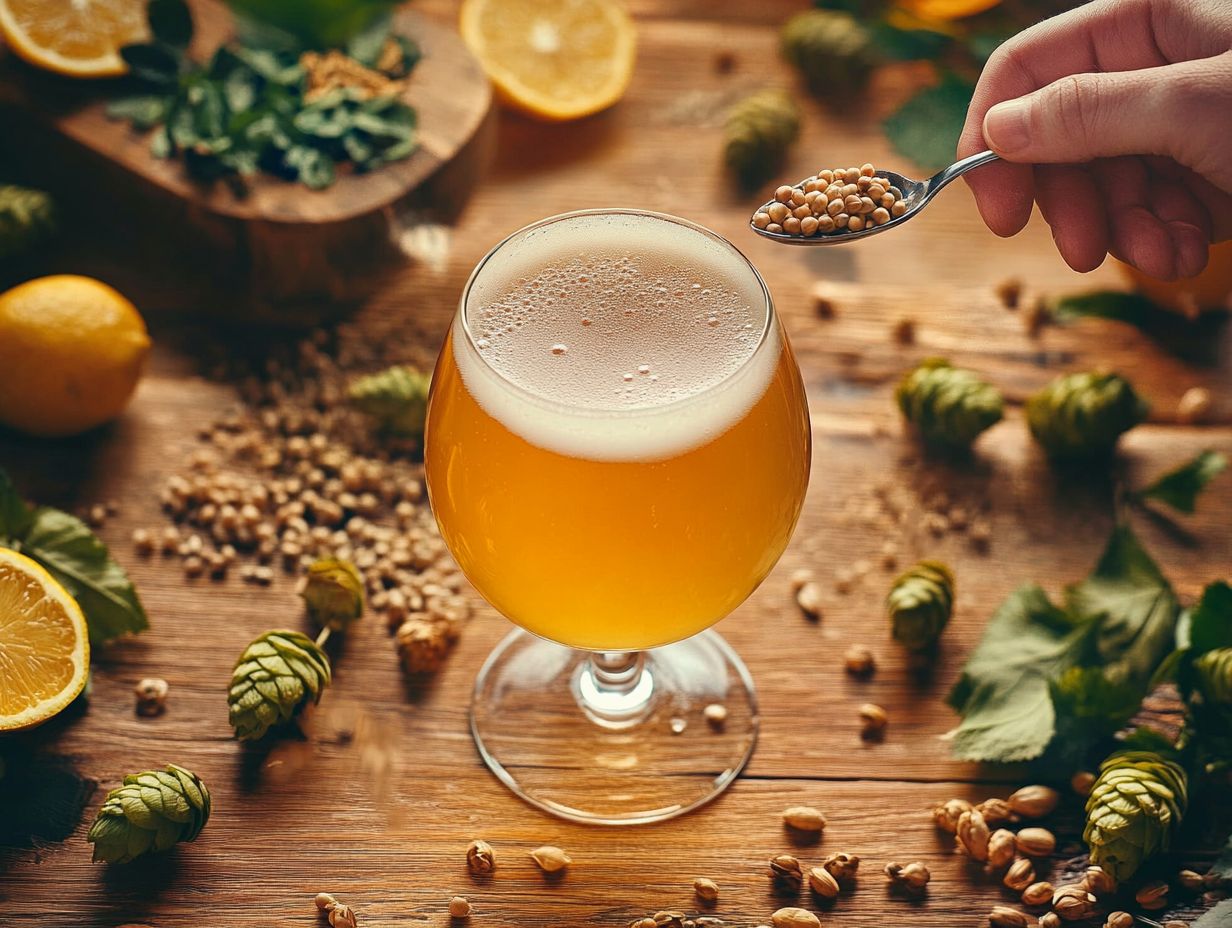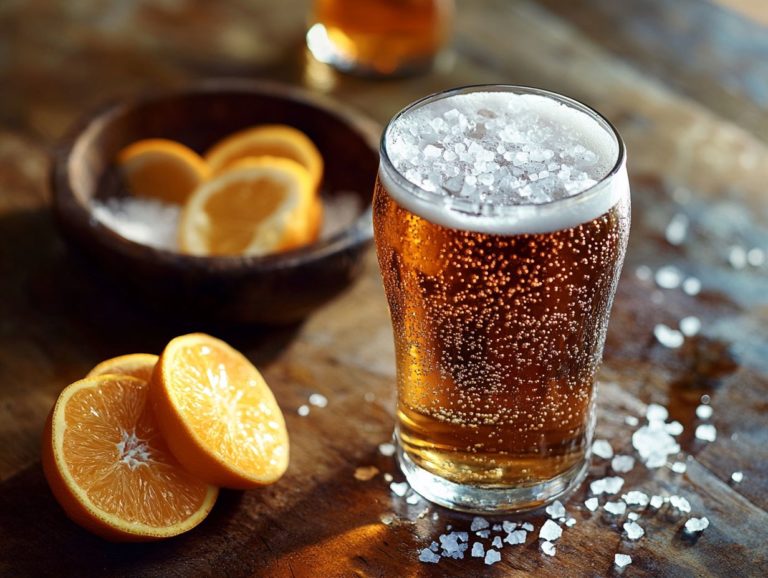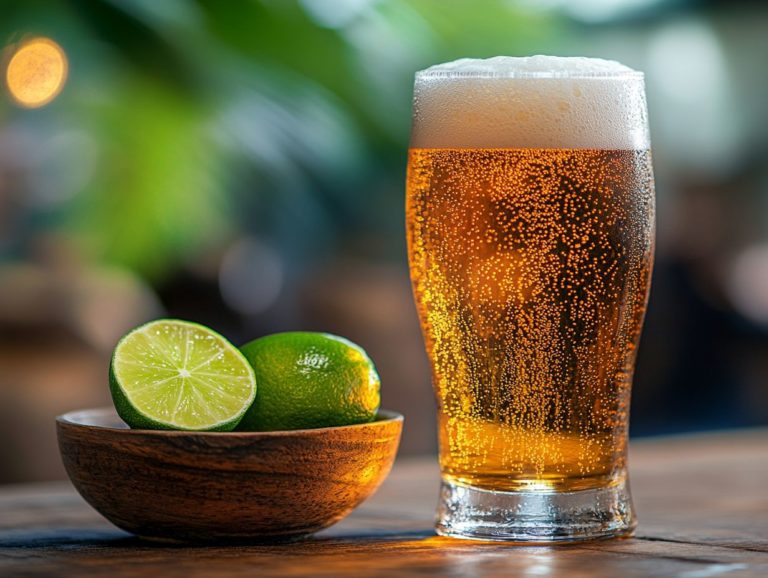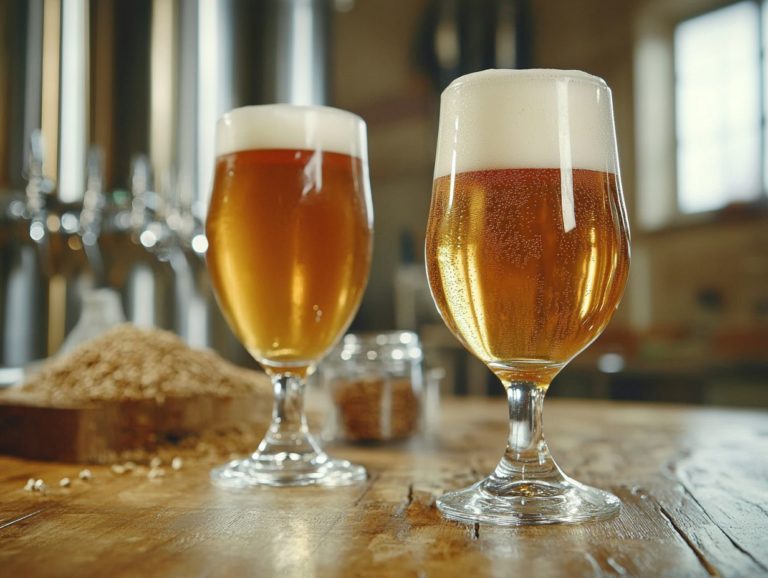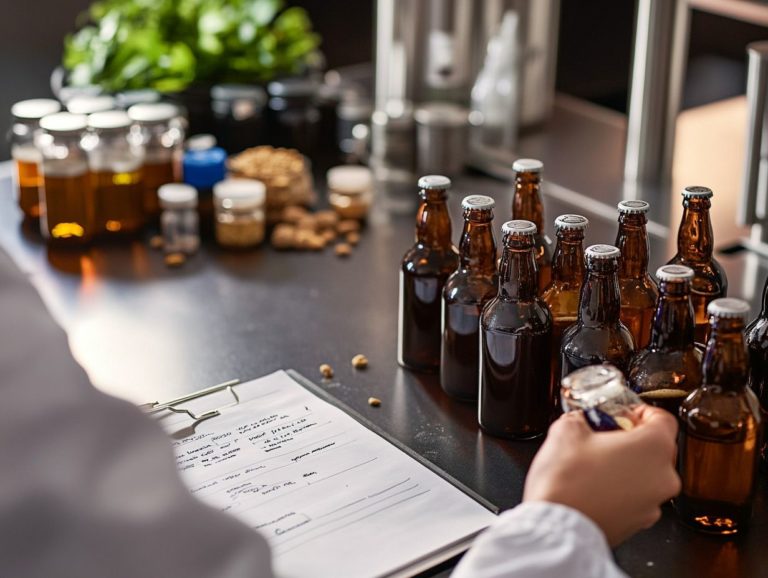What to Do When Your Beer Lacks Flavor
Beer enthusiasts know that enjoying a perfect brew can quickly decline if it loses its flavor. This is especially true for pale beers.
Elements such as light exposure, oxygen, dirty draft lines, and temperature fluctuations can strip beer of its true character. This leads to a lackluster experience with every sip.
Delve into the reasons behind this flavor loss and learn how to recognize when it occurs. Arm yourself with practical tips from the brewing community to keep your beer tasting impeccably fresh.
Uncover innovative methods to revive a flat bottle. Try incorporating brewing recipes featuring malt extract syrup or using homebrewing kits like Brewers Best. Let s dive into the exciting world of flavorful brews!
Contents
- Key Takeaways:
- Why Does Beer Lose Flavor?
- What Causes Beer to Lose Flavor?
- How Can You Tell if Your Beer Has Lost Flavor?
- How Can You Prevent Beer from Losing Flavor?
- What Can You Do if Your Beer Has Already Lost Flavor?
Key Takeaways:
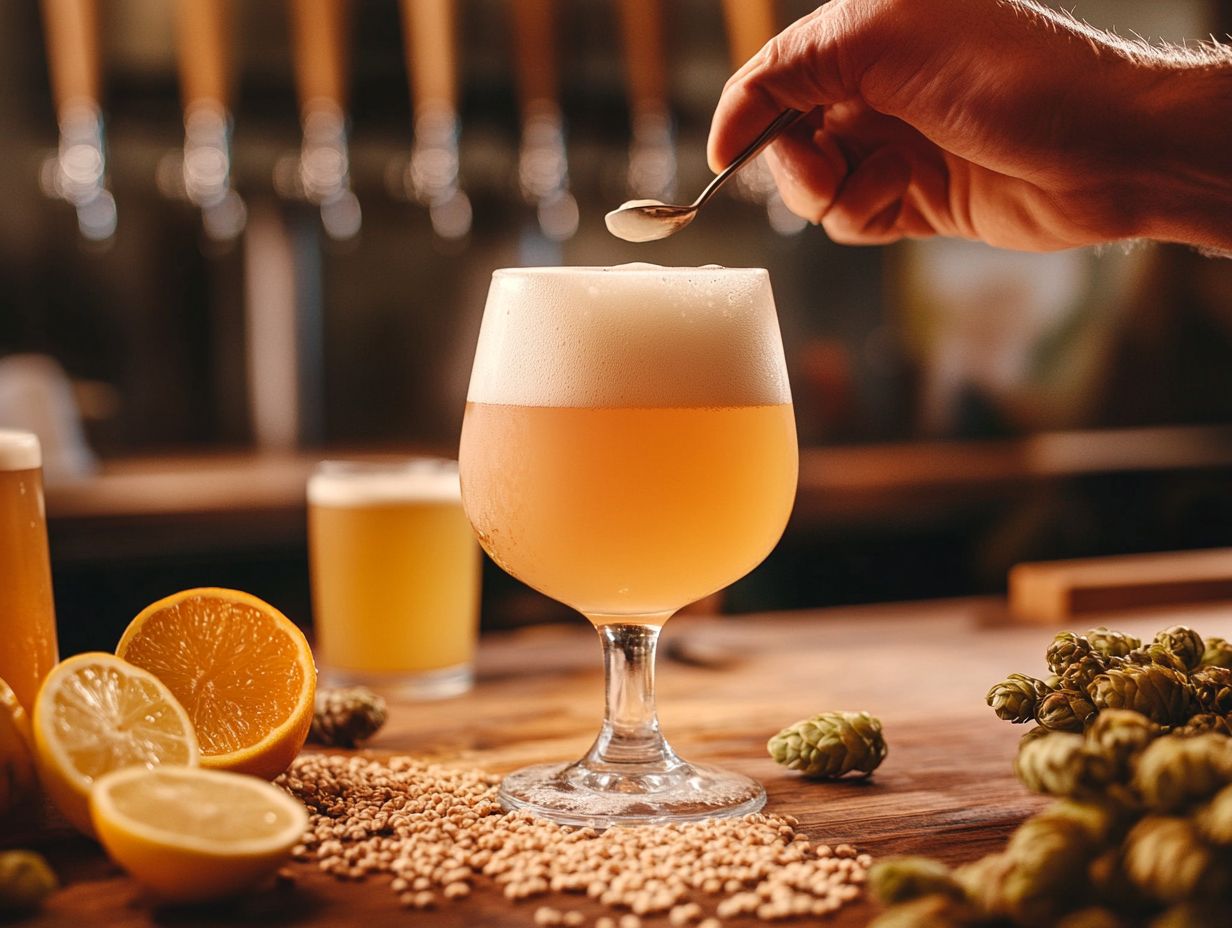
- Proper storage and avoiding light exposure can prevent beer from losing flavor. Consider using UV-resistant bottles or cans for better beer packaging.
- Smell, taste, and appearance are key indicators of a beer lacking flavor. Conduct a beer sensory evaluation to assess these aspects.
- If your beer has already lost flavor, try adding flavoring agents, mixing with other beers, such as a Sparrow Hawk Porter, or using it in cooking or cleaning.
Why Does Beer Lose Flavor?
Beer, a cherished beverage steeped in history, can lose its allure for many reasons. This impacts both its quality and your experience as a drinker.
Brewing batches with stringent quality control can minimize these issues. Factors such as brewing techniques, like the water profile and sodium chloride levels, can diminish taste and aroma profiles. This ultimately leads to a less satisfying beer experience.
It’s important for both brewers and consumers to grasp these factors. Flavor compounds, beer consistency, and specific styles significantly influence the overall appeal of the final product.
To truly appreciate the intricacies of beer, you must recognize how preservation methods and environmental elements can transform its characteristics over time.
What Causes Beer to Lose Flavor?
Numerous factors can diminish the flavor of beer, each playing a pivotal role in shaping the consumer’s experience.
For instance, exposure to light can lead to undesirable bad flavors caused by light exposure. Additionally, oxygen exposure tends to introduce off-flavors reminiscent of stale or cardboard notes.
Temperature fluctuations during brewing or storage can disrupt the fragile balance of flavor compounds. Improper aging of the beer can further compromise its taste.
Chemical residue from brewing equipment can also affect flavor. The health of the yeast used in fermentation, such as Nottingham dry yeast, is also vital. These elements significantly influence the integrity of the beer’s flavor.
1. Light Exposure
Light exposure significantly contributes to the degradation of beer flavor. This often leads to undesirable lightstruck notes that can spoil even the most exquisite beer styles.
This phenomenon occurs when ultraviolet (UV) light interacts with certain compounds in beer, particularly in lighter-colored brews. This results in off-flavors that might remind you of skunk.
To keep your beer’s taste and aroma intact, understand the brewing methods and packaging that help reduce this risk. Take pilsners and pale ales, for example. These styles are particularly susceptible to lightstruck flavors due to their use of pale malts and hops.
To combat this issue, many breweries choose brown or black bottles, which offer a far more effective barrier against light than clear or green options. You might also encounter techniques like UV-resistant coatings or the use of cans that further protect the beer from light exposure.
If you re a homebrewer, consider adopting practices such as fermenting in dark environments, utilizing opaque fermentation vessels, and conditioning in light-proof containers. Homebrewing kits from Northern Brewer can be very helpful in this regard.
These steps can help you preserve the intended flavor profile and elevate the overall drinking experience.
2. Oxygen Exposure
Oxygen exposure poses a significant risk to the flavor of your beer. It often leads to the emergence of off-flavors like diacetyl and acetaldehyde, which can undermine the overall quality of your brew.
When oxygen interacts with flavor compounds during brewing or aging, it can produce stale or oxidized notes that detract from your carefully crafted beer profile. Managing oxygen levels during fermentation and storage is crucial for preserving freshness and enhancing the sensory characteristics of your beer.
To identify these undesirable changes, you can conduct sensory evaluations and utilize a method to analyze beer compounds to detect volatile compounds linked to oxidation.
Techniques such as purging containers with CO2 before filling, using airtight seals, and minimizing transfer time between vessels can significantly reduce oxygen exposure during fermentation and bottling.
Incorporating antioxidant additions or specialized packaging can further inhibit the harmful effects of oxygen, ensuring that your final product retains its intended flavors and aromas. Taking these proactive measures is essential for anyone dedicated to upholding high-quality standards in their brewing craft.
3. Temperature Fluctuations
Temperature fluctuations can profoundly affect your brewing process and result in a notable loss of flavor in your beer. Proper management of fermentation temperature is essential.
From fermentation temperature to the aging process, maintaining a stable temperature is crucial for yeast health and the production of desirable flavor compounds.
Drastic temperature changes may lead to unwanted off-flavors, throwing your carefully crafted brew off balance. Consistency in fermentation temperature plays a critical role in your brewing success.
By understanding how temperature influences brewing, you can create consistent, high-quality beer that retains its intended flavors. Brewing demands meticulous attention to temperature at various stages, especially during fermentation when yeast is most active.
If the fermentation temperature climbs too high, you risk a rapid fermentation that can introduce off-flavors. Conversely, if the temperature dips too low, yeast activity may come to a halt, resulting in incomplete fermentation and a dearth of those delightful esters, the fruity flavors that enhance beer character.
To achieve the optimal results you desire, closely monitor your fermentation vessels with temperature control systems, such as water baths or dedicated fermentation chambers. Proper management during the cooling phase can significantly enhance your beer’s clarity and flavor profile, ensuring that the final product is nothing short of exceptional.
4. Age
The age of your beer is crucial to its flavor experience. Some brews are crafted for aging, while others shine brightest when enjoyed fresh.
Aging your beer properly can unlock amazing flavors, as chemical reactions can alter its flavor profile over time, potentially leading to a loss of freshness or even the emergence of off-flavors.
By understanding the optimal shelf life for various brewing techniques and beer styles, you can truly appreciate and preserve the intended flavor profile over time.
Take, for example, strong ales, barleywines, and lambics; these are the kinds of beers that often thrive with age, developing richer and more complex flavors and aromas as they mature. Radical Brewing by Mosher is a great resource for learning more about these styles.
On the flip side, hop-forward styles like IPAs and pale ales are best enjoyed fresh, as aging can diminish their lively hop character.
Don t underestimate the impact of storage conditions on this aging journey. High temperatures can invite unwanted oxidation and spoilage, while cooler, darker spots typically allow for a more graceful evolution.
Additionally, variations in humidity and light exposure can significantly affect quality. It is essential for craft beer aficionados like you to carefully consider how and where you store your beloved bottles.
How Can You Tell if Your Beer Has Lost Flavor?
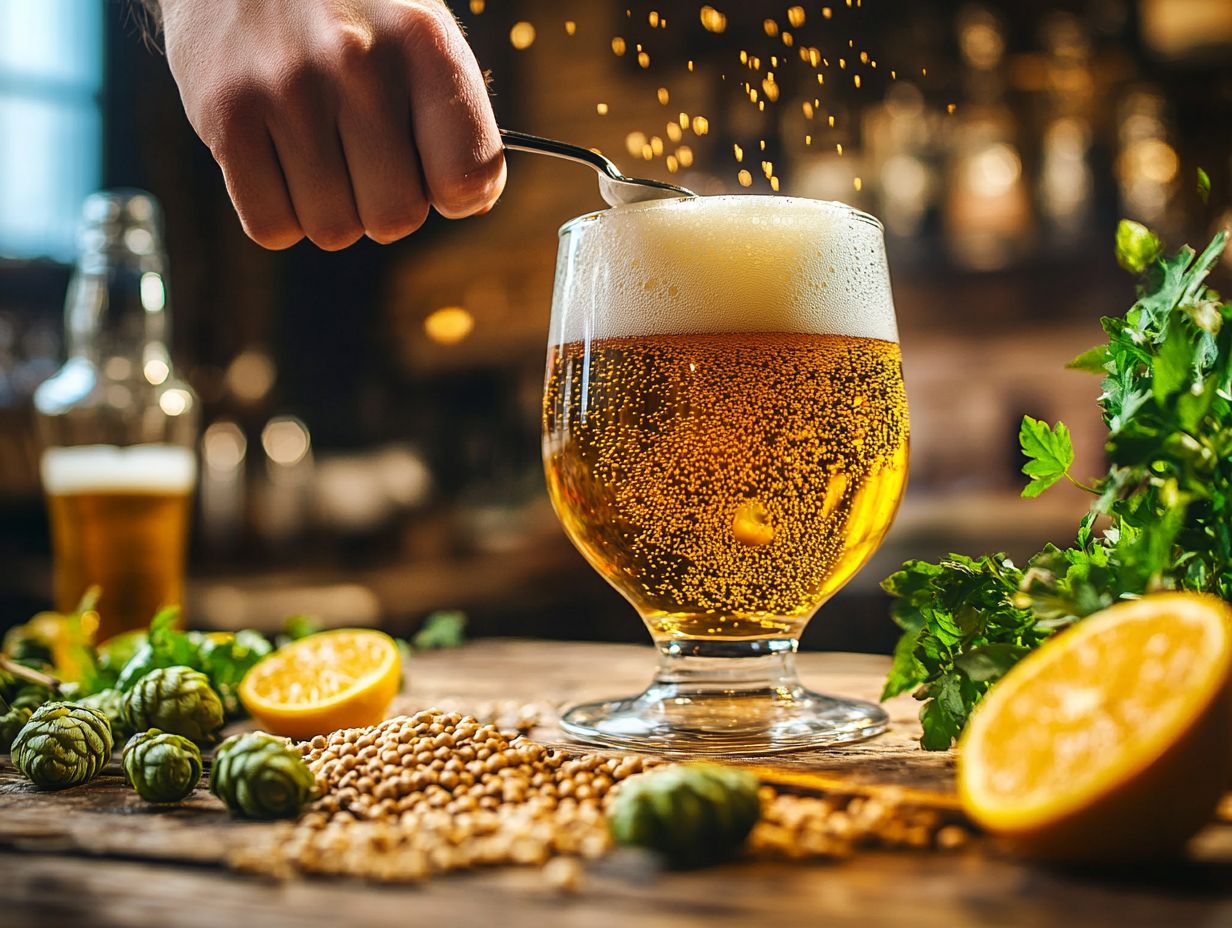
Detecting whether your beer has lost its flavor requires a thoughtful engagement of your senses primarily taste, aroma, and visual characteristics. This process is often covered in Cicerone Certification programs.
The taste should be well-balanced and aligned with the intended profile. Any off-flavors may suggest spoilage or improper storage conditions. This is why following brewing advice from reputable sources like Papazian is important.
The aroma offers vital clues about freshness. If you encounter a stale or muted scent, this can mean your beer has lost its zing!
Observing the beer s appearance, including clarity and color, will also provide insights into its quality and overall flavor experience.
1. Smell
Smelling your beer is one of the most revealing indicators of its freshness and flavor integrity. Aroma compounds from brewing ingredients play a pivotal role in your overall beer experience.
A vibrant aroma speaks volumes about freshness, while off-flavors like skunky or stale notes can signal a decline in quality. By evaluating the aroma of the beer, you can assess its quality and determine whether it has lost essential flavor characteristics.
To truly appreciate the bouquet of a beer, you should engage your senses thoughtfully. Joining the Cicerone Certification program can help you develop these skills further.
Hold the glass at a slight angle and gently swirl it to release those elusive volatile aromas. Inhale deeply through your nose to capture a wide range of scents, from fruity to malty to hoppy notes that reveal the brewer’s intent.
Be mindful of common off-aromas, like diacetyl, a compound that can give beer a buttery taste, or oxidized, which can give the beer a stale taste; these can indicate that the beer is past its prime. Brewing classic styles can help you master the nuances of these aromas.
Ideally, fresh beer should present a clean, inviting aroma that enhances its flavor profile.
It s essential to practice these smelling techniques regularly to refine your sensory evaluation skills and elevate your beer-tasting experience, especially if you’re working towards your Cicerone Certification.
2. Taste
Tasting your beer is a definitive way for you to determine if it has lost its vibrant flavor. A fresh beer should present a balanced profile, with pronounced flavor compounds that reflect its unique style.
If you detect any off-flavors like sourness, astringency, or metallic notes or specific off flavors like diacetyl flavor or acetaldehyde flavor it’s a clear sign that the beer hasn t been stored properly or has surpassed its optimal shelf life.
Engaging your palate fully will lead you to a deeper understanding of the beer s quality and character.
To truly appreciate the nuances of your brew, consider adopting a systematic approach to your tasting. Begin by observing the beer s appearance; a clear, vibrant hue indicates freshness, while cloudiness may suggest spoilage.
Gently swirl the glass to release the aromatic compounds, then take a moment to inhale the delightful bouquet that forms above. This is a crucial step in beer sensory evaluation.
When you take a sip, hold the liquid in your mouth for a few seconds to identify the initial flavors before they evolve into something more complex.
Seek out a harmonious balance between malt sweetness, hop bitterness, and carbonation; any noticeable imbalance could signal off-putting flavors.
Familiarize yourself with common off-flavors, such as diacetyl or DMS, which can often obscure the intended profile of the beer. This knowledge will enhance your tasting experience and provide valuable insights into its handling and brewing process.
Always consider the fermentation temperature and yeast type, as they significantly affect the final flavor profile.
For more on mastering beer tasting, consider signing up for a Cicerone Certification program or exploring additional resources!
How Can You Prevent Beer from Losing Flavor?
To prevent your beer from losing its delightful flavor, you must pay attention to several crucial factors. Proper storage is paramount; keep your beer protected from light exposure and maintain consistent fermentation temperatures. Being mindful of your water profile and any chemical residue during the brewing process can also significantly contribute to flavor retention.
Store your beer in dark, cool places to preserve its intended flavor profile and overall quality. Understanding the brewing methods that contribute to flavor retention enables you, as a homebrewer, to craft beers that truly stand the test of time.
1. Proper Storage
Proper storage is essential for maintaining the quality of your beer and extending its shelf life. Improper conditions can lead to rapid flavor loss. Store your beer in a cool, dark environment, away from direct sunlight and temperature fluctuations that can degrade its delicate flavor compounds. Understanding the ideal storage practices ensures that your beer retains its intended characteristics, leading to a more enjoyable drinking experience.
For optimal results, lagers thrive at colder temperatures ranging from 34 F to 40 F, preserving their crispness and refreshing taste. On the other hand, ales perform exceptionally well at slightly warmer settings, ideally between 45 F and 55 F, allowing their more complex flavors to truly shine through. Avoid heat sources, such as kitchens or basements near appliances, as these can lead to undesirable changes in flavor.
Storing your beer upright is another smart move; it minimizes the risk of disturbing sediment, especially for bottle-conditioned varieties, ensuring you achieve an optimal pour. By adhering to these storage principles, you can significantly enhance the longevity and enjoyment of your favorite brews. Utilizing proper brewing equipment and brewing kits like those from Brewers Best can also ensure better storage outcomes.
3. Appearance
The appearance of your beer is essential in assessing its quality, with clarity, color, and foam head serving as key indicators of freshness. A hazy or dull beer might raise red flags, suggesting it has spoiled or experienced undesirable changes during the brewing process. Observing the beer’s consistency and overall look can provide valuable insights into its brewing methods, brewing variables, and potential flavor integrity.
When evaluating, pay close attention to the beer’s carbonation level the bubbles in the beer that give it a fizzy texture. A flat beer often signals a lack of freshness, which will undoubtedly lead to a diminished taste. The foam head not only enhances the beer’s aesthetics but also serves as a telltale sign of the brewing technique and ingredients used, including the specific types of malt and hops incorporated. Checking the beer consistency also provides clues about its freshness and quality.
Different brewing methods, such as fermentation temperature and time, significantly impact both the look and taste of the beer. Improper techniques can result in visual and flavor degradation. Taking a closer look at a beer s appearance before tasting it can provide more than just a first impression; it can offer crucial hints about its overall quality and the enjoyment that awaits. For homebrewers, familiarizing themselves with these methods and the brewing process can be particularly beneficial.
In conclusion, understanding the appearance, storage conditions, and brewing techniques of beer can significantly enhance your tasting experience. By implementing these practices, you will preserve the unique flavors and qualities of your favorite brews!
2. Avoiding Light Exposure
Avoiding light exposure is crucial for preserving the exquisite flavor of beer. Light can introduce off-flavors that mar the overall drinking experience. This light exposure often leads to lightstruck flavor, commonly known as skunky beer. By opting for suitable beer packaging, like brown bottles or cans, you can significantly reduce the risk of light interacting with the beer, thus preventing flavor degradation.
Using clear or green bottles allows light to seep in more easily, resulting in that notorious skunky taste many beer lovers know all too well. This is a classic example of lightstruck beer. Therefore, choosing brown bottles is often considered the gold standard.
Moreover, the introduction of UV-blocking coatings on cans cleverly protects beer from harmful light without sacrificing the visibility needed for branding. This technique is particularly beneficial in safeguarding the beer’s flavor compounds.
Brewers can also employ specialized brewing methods to minimize light exposure during production. Selecting hop varieties that are less prone to light-induced degradation is one way to achieve this. Choose the right brewing ingredients and understand the brewing variables to help maintain the beer’s intended flavor.
Get to know these elements to elevate your beer experience!
3. Keeping Beer Cold
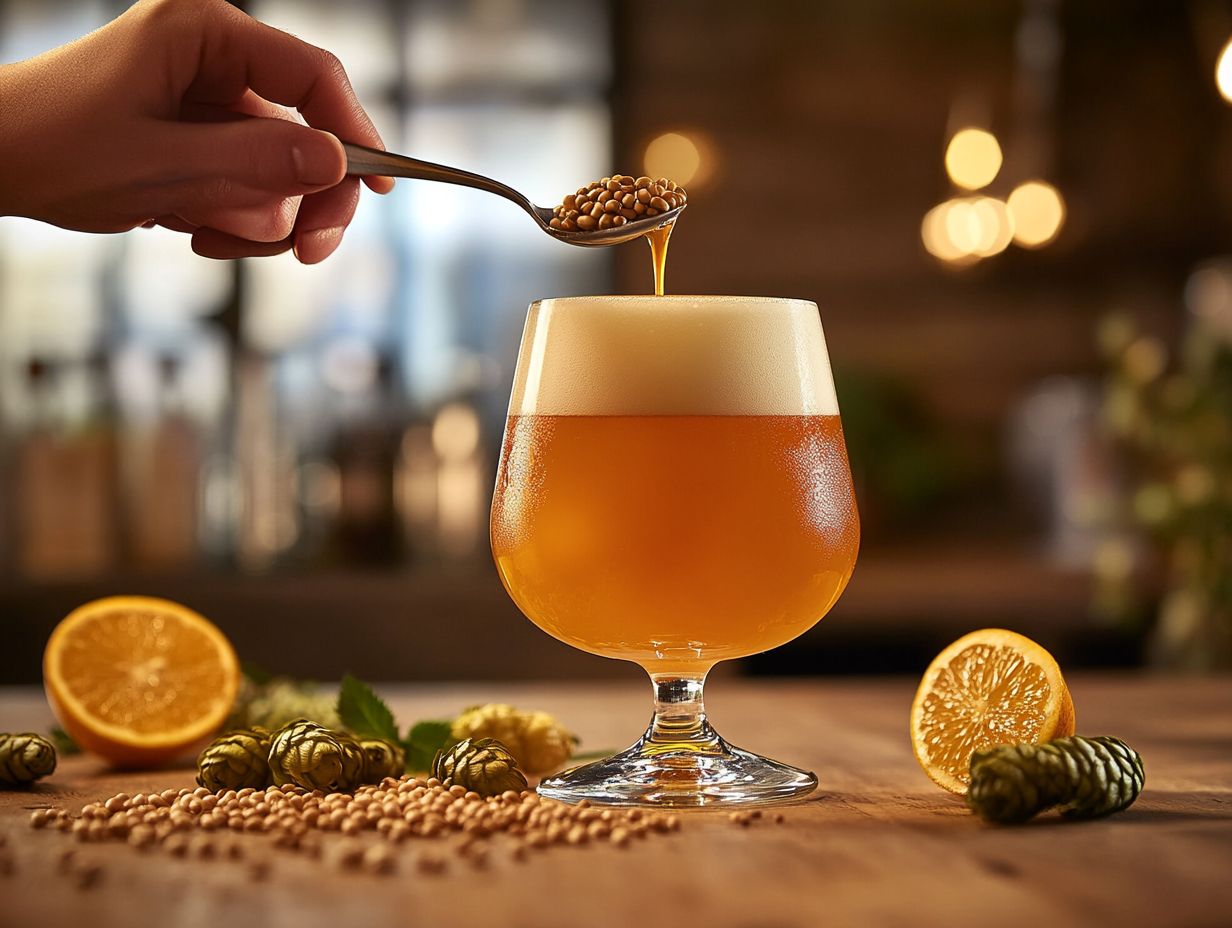
Keeping your beer cold is essential for preserving its quality and flavor. Temperature significantly influences the fermentation process and how well those delightful flavors hold up. Ideally, enjoy beer at the recommended serving temperatures for each style; this practice helps express the intended flavor profile and aromatic nuances.
For instance, lighter beers like lagers and pilsners are best served chilled, typically between 38-45 F, to accentuate their crispness and refreshing qualities. On the flip side, bolder beers such as stouts and porters thrive at slightly warmer temperatures, around 50-55 F, allowing their rich, complex flavors and enticing aromas to emerge fully. Paying attention to recommended serving temperatures ensures you enjoy each beer style as intended by the brewer.
Improper storage particularly at fluctuating or extreme temperatures can introduce off-flavors, spoilage, or even that dreaded skunky taste. This undermines all the brewer’s careful craftsmanship. Therefore, whether you re a connoisseur or a casual drinker, it’s worth paying attention to these temperature nuances.
Doing so will allow you to truly savor each pint, ensuring that the delightful characteristics of your beer shine through beautifully.
4. Consuming Fresh Beer
Have you ever wondered how to keep your beer tasting fresh? Consuming fresh beer is one of the most rewarding ways to truly savor its full flavor potential, especially since many beer styles are best enjoyed shortly after production. By understanding the shelf life of different beers and the brewing techniques that influence freshness, you can make informed choices about selecting and enjoying your favorite brews at just the right moment.
Factors like the type of beer, its ingredients, and the brewing methods all play a significant role in how long a beer can maintain its delightful flavor compounds.
To spot fresh beers in the market, check for production or bottling dates on the packaging; these dates are essential indicators of freshness. Typically, hoppy styles like IPAs shine brightest within a few months post-production, while darker beers such as stouts may retain their flavor for a longer stretch. It’s fascinating to note that beers conditioned with live yeast can continue to evolve in flavor, sometimes even improving over time, enhancing your tasting experience.
When you re shopping, seek out breweries that emphasize quality control and transparency; this often reflects their dedication to delivering fresher products. Consider storage conditions when enjoying your beer keeping it in a cool, dark place can significantly extend its freshness. And don t forget to serve it at the ideal temperature to truly enhance its taste.
What Can You Do if Your Beer Has Already Lost Flavor?
If your beer has already lost its flavor, there are a variety of creative strategies to turn the situation around! Consider incorporating flavoring agents like sodium chloride, or use the beer in cooking or even for cleaning tasks.
Experiment with brewing recipes that highlight bold flavors and intriguing additives to effectively mask unpleasant notes and reclaim some enjoyment from your beverage. Try recipes from sources like Radical Brewing by Randy Mosher. Consider innovative ways to repurpose beer in your culinary endeavors or cleaning routines, ensuring that nothing goes to waste. This approach is well-supported by the brewing community, which often shares valuable brewing advice.
1. Add Flavoring Agents
Consider adding pumpkin spice to create a seasonal treat similar to a pumpkin porter, or experiment with other bold ingredients to enhance the beer’s flavor.
Adding flavoring agents to your beer is a brilliant strategy when dealing with flavor loss. These ingredients can enhance or even restore the intended taste profile. Incorporate spices, fruits, or even extra hops to create innovative brewing recipes that breathe new life into stale beer, transforming it into an exciting flavor experience. Understanding how different flavoring agents interact with the existing compounds in your beer can lead to successful reinventions of your brew.
For example, a classic wheat beer can shine with a touch of coriander and orange peel, accentuating its natural fruitiness while preserving that refreshing taste. Conversely, a robust stout can thrive with the inclusion of espresso beans or chocolate, resulting in a rich, layered flavor profile.
When choosing flavoring agents, think about the base style and overall balance. Lighter beers harmonize beautifully with citrusy or floral notes, while darker brews can confidently embrace more intense flavors. Remember, experimenting is your best friend, so start with small amounts to ensure you don t overpower the original brew.
2. Mix with Other Beers
Mixing your beer with complementary brews can be an exciting and effective way to restore flavor while exploring new taste combinations! By blending different brewing techniques and styles, you can craft unique flavor profiles that elevate your overall drinking experience.
This approach helps mask any less-than-desirable flavors and opens up innovative avenues for enjoying beer. To achieve a well-balanced blend, grasp the characteristics of various styles. For example, combining a hoppy IPA with a malty stout creates an intriguing contrast between bitterness and sweetness.
Experimentation is key. Consider starting with a ratio of one part stout to two parts IPA. Techniques like barrel-aging or dry hopping can further enhance the complexity of your blends dry hopping involves adding hops during fermentation for extra aroma and flavor.
As you combine, pay attention to the texture, aroma, and aftertaste, ensuring they harmonize and elevate one another rather than clash. This process challenges conventional brewing standards and invites creativity and personal expression into your brewing journey.
3. Use in Cooking or Baking
Using stale beer in your cooking or baking isn t just practical; it s a brilliant way to salvage its flavor! Many recipes benefit immensely from the depth that beer provides. Imagine whipping up beer-battered fish or indulging in rich brownies made with stout finding creative ways to use beer turns flavor loss into a delightful culinary adventure.
For instance, a pale ale can elevate a classic chili recipe, or a dark lager can add luxurious richness to your homemade bread. For dessert, think about incorporating a fruity beer into a cake recipe; it infuses unexpected notes that pair beautifully with frostings or chocolate.
But the wonders of beer don t stop in the kitchen! Its effervescence makes it an unexpected ally for household chores; the acid and carbonation work wonders for cutting through grease and removing tarnish from metal surfaces. By exploring both culinary applications and practical uses, stale beer transforms from a forgotten beverage into a versatile ingredient that enhances flavors and helps maintain a cleaner home.
4. Use as a Cleaning Agent
Stale beer can surprisingly serve as an effective cleaning agent, thanks to its natural properties that cut through grease and grime. The carbonation in beer lifts dirt, making it an unexpected yet powerful alternative for cleaning various surfaces around your home. By embracing the potential of stale beer for your cleaning tasks, you can reduce waste while taking advantage of its beneficial attributes.
This versatile liquid can assist you in scrubbing kitchen surfaces, shining metal fixtures, and even conditioning wooden furniture. For instance, when faced with stubborn stains on your countertops, simply pour a small amount of stale beer onto a cloth and wipe the area clean; the acids in the beer work to break down tough residues.
Regarding cleaning tarnished brass or copper items, mixing stale beer with lemon juice creates an excellent natural polish. Beyond traditional cleaning, stale beer can also freshen up carpets. Just spray a diluted solution onto the fabric, allow it to sit for a few minutes, and then blot it with a clean cloth for an effective odor-reducing effect.
Frequently Asked Questions
What to Do When Your Beer Lacks Flavor?
If your beer is lacking flavor, there are a few things you can do to enhance the taste.
Why does my beer lack flavor?
There are a few reasons why your beer may lack flavor. It could be due to improper storage, an expired or old bottle, or a low-quality beer.
How can I store my beer properly to prevent it from losing flavor?
To ensure your beer maintains its flavor, store it in a cool and dark place away from direct sunlight. Avoid storing it in the fridge for too long as this can also affect the taste.
What can I do if my beer is expired or old?
If your beer is past its expiration date or has been sitting around for a while, the best thing to do is to replace it with a fresh one. Expired beer can taste stale and lose its flavor.
Can I add ingredients to my beer to enhance the flavor?
Yes, you can add ingredients to your beer to enhance the flavor. Some popular options include fruit, spices, and herbs. Just make sure to research the right amount to add to avoid overpowering the original flavor.
What should I do if my beer tastes watered down?
If your beer tastes watered down, try pouring it into a glass with a smaller surface area to allow the flavors to concentrate. You can also try adding a pinch of salt to help bring out the taste.

